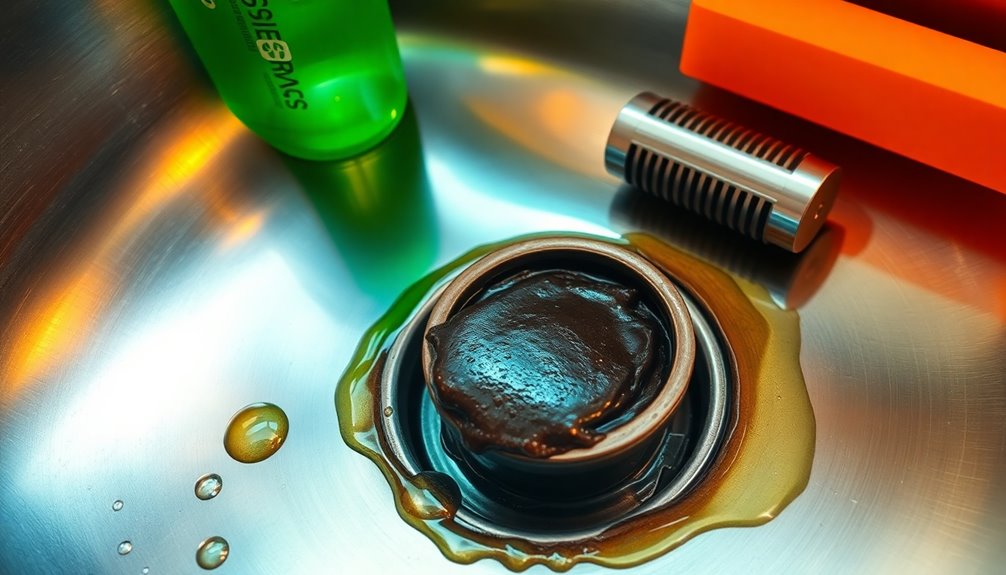To unclog grease from your kitchen sink, start by wearing rubber gloves and removing standing water. Try using a cup plunger to create pressure or mix ½ cup of baking soda with ½ cup of vinegar, cap it for an hour, then flush with hot water. Boiling water and dish soap can also break down grease. If these methods don't work, there are advanced techniques and tips for maintaining clear drains that can help you manage stubborn clogs.
Key Takeaways
- Start by removing standing water from the sink to access the clog effectively.
- Use a cup plunger to create pressure and dislodge the grease blockage.
- Pour a mixture of ½ cup baking soda and ½ cup vinegar down the drain, then flush with hot water.
- For stubborn clogs, consider using a wet-dry vacuum or an auger to break through the blockage.
- If DIY methods fail, call a professional plumber for specialized tools and expertise in grease removal.
What Causes Grease Build-Up in Kitchen Drains?
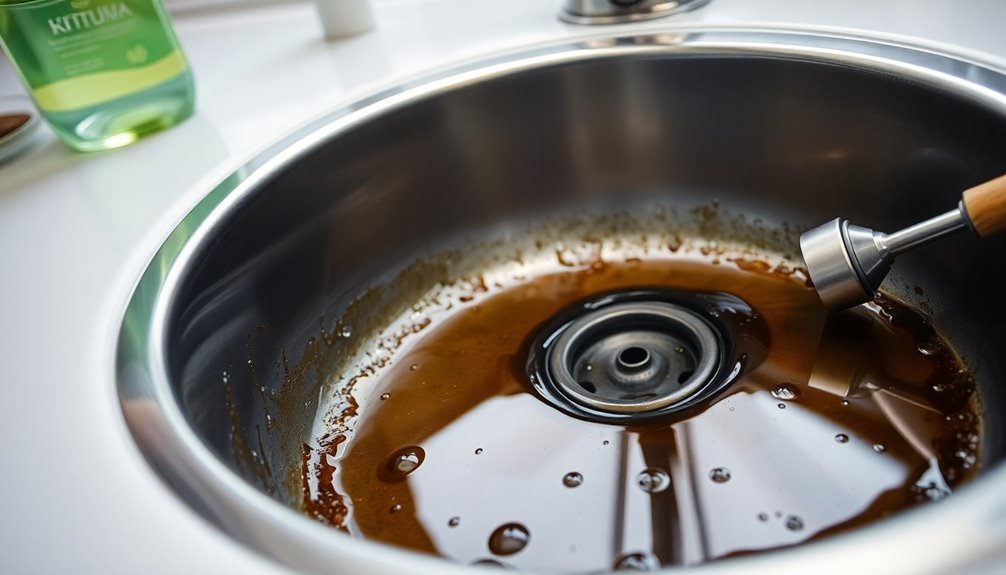
When you wash greasy dishes, the fats and oils often make their way down the drain, leading to frustrating grease build-up in your kitchen pipes.
This grease, which comes from cooking oils and fats from meat, butter, and dairy, cools and solidifies inside the pipes. Over time, it narrows the passageway, making your drain slow to empty.
If you mix food waste with grease in a kitchen sink, you create a sticky residue that traps even more debris, increasing the risk of a clogged drain.
To prevent this, it's important to dispose of grease properly—use a container instead of washing it down the sink.
Regular maintenance can help your drains function smoothly and drain quickly.
Signs Your Drain Is Clogged With Grease

Noticing signs of a clogged drain can save you from bigger plumbing issues down the line.
If you experience any of the following symptoms, it's likely that grease is building up in your pipes:
- A foul odor emanating from the drain.
- Gurgling sounds when running water down the sink.
- Slow drainage, with water taking longer than usual to disappear.
- Frequent backups, especially after using the garbage disposal.
- Unpleasant smells lingering in the kitchen, particularly near the sink.
These indicators suggest that grease is obstructing the flow in your plumbing.
Don't ignore these signs; addressing them early can prevent more serious problems later on.
Stay attentive to your kitchen's drainage and maintain a clean environment.
Initial Steps for Unclogging a Kitchen Sink
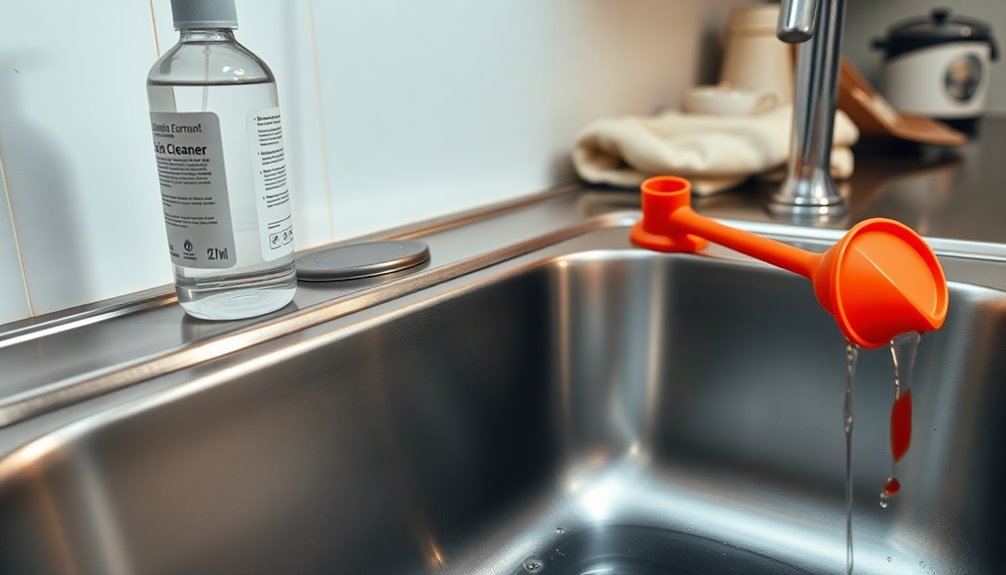
Before diving into unclogging your kitchen sink, it's essential to take some initial steps to guarantee the process goes smoothly.
Start by putting on rubber gloves to protect your hands from debris and bacteria. Next, remove any standing water from the sink using a cup or basin, which will help you access the drain directly.
Assess the severity of the grease clog you're facing. Try using a cup plunger to create pressure—make sure there's enough water in the sink to properly submerge the plunger head.
If that doesn't work, pour a mixture of baking soda and vinegar down the drain, cover it, and let it sit for 15 minutes before flushing with hot water. This should help unclog your sink effectively.
Using Boiling Water to Dissolve Grease Clogs
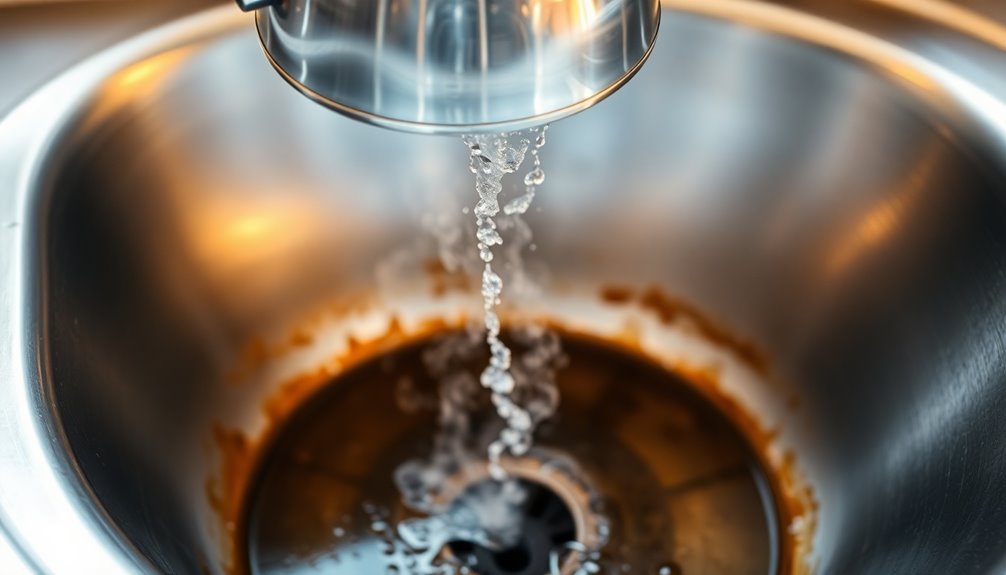
Using boiling water is a simple and effective way to tackle grease clogs in your kitchen sink.
Just remember to follow safety precautions to avoid damaging your pipes, especially if they're PVC.
Let's go through the benefits and the step-by-step process to make sure you get it right.
Benefits of Boiling Water
When grease clogs start to build up in your kitchen sink, boiling water can be a quick and effective solution to dissolve those stubborn blockages. It works by melting away accumulated fats and oils, allowing them to flow freely down the drain.
Here are some benefits of using boiling water for drain cleaning:
- Dissolves minor grease clogs quickly
- Enhances the effectiveness when combined with dish soap
- Can be repeated for stubborn blockages
- Serves as a preventative measure against future clogs
- Safe for metal pipes, promoting smoother drainage
Using boiling water regularly can help you easily unclog a sink and maintain ideal flow in your kitchen plumbing, making it a handy tool in your cleaning arsenal.
Safety Precautions Needed
While boiling water is an effective method for clearing grease clogs, it's important to prioritize safety during the process. Always wear heat-resistant gloves and safety goggles when handling boiling water to protect yourself from burns and injuries.
Before pouring, make sure the sink is free of standing water to prevent splashing and allow better drainage. Pour the boiling water in a slow, steady stream to effectively dissolve the clog without overwhelming your pipes.
Be cautious with PVC pipes, as extreme heat can damage them; consider using hot water instead. Allow the boiling water to sit in the drain for several minutes to maximize its effectiveness, and follow up with more hot water to flush the system.
Step-by-Step Application
Boiling water is one of the most effective ways to tackle stubborn grease clogs in your kitchen sink. Here's how you can do it:
- Boil half a gallon of water in a kettle until it reaches a rolling boil.
- Remove any standing water from the sink using a cup or basin.
- Pour the boiling water down the kitchen drain in a steady stream to melt and dissolve the grease clog.
- If the clog persists, let the pipes cool for a few minutes, then repeat the process as needed.
- Always exercise caution to avoid damaging PVC pipes; consider using hot water instead.
The Baking Soda and Vinegar Method
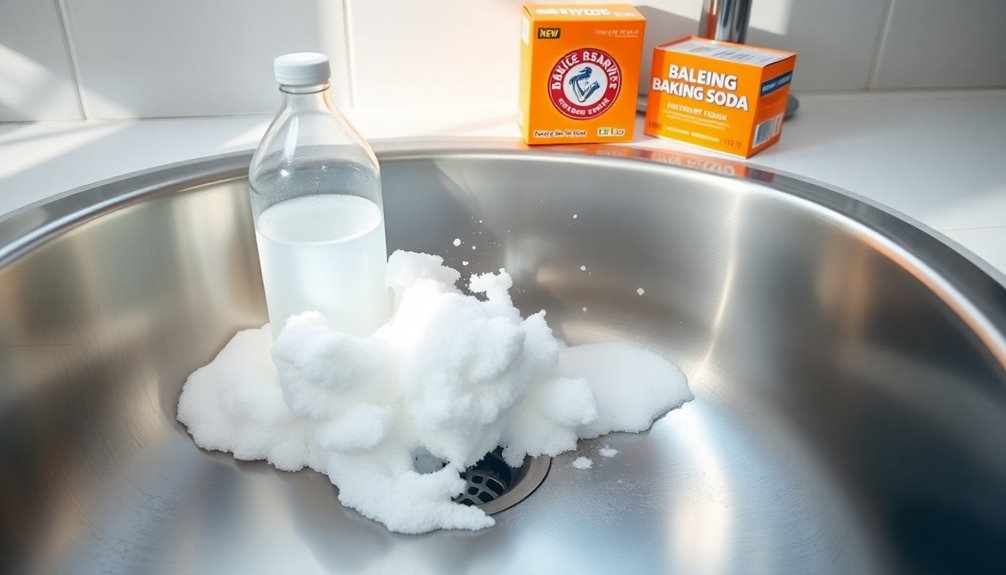
One effective way to unclog a kitchen sink is by using the baking soda and vinegar method. Start by pouring one cup of baking soda down the drain, followed by one cup of vinegar. This combination creates a bubbling reaction that helps break down the grease. Cover the drain with a rubber stopper and let it work for about 15 minutes. Afterward, rinse the drain with hot tap water until it runs clear. If your sink is still clogged, repeat the process two to three times.
| Step | Ingredient | Purpose |
|---|---|---|
| 1 | Baking Soda | Breaks down grease |
| 2 | Vinegar | Creates bubbling reaction |
| 3 | Rubber Stopper | Contains the reaction |
| 4 | Hot Water | Flushes out loosened debris |
| 5 | Repeat | Guarantees thorough cleaning |
How to Check and Clear Your Garbage Disposal

Sometimes, a garbage disposal can become a source of frustration when it's not functioning properly. To check and clear your disposal, start by ensuring it's plugged in and pressing the reset button if needed.
If it's jammed, turn it off and use a wrench to manually turn the blades through the access hole, removing any debris. Running cold water while using the disposal helps flush food particles and prevents plumbing issues.
- Avoid fibrous materials like celery and large food scraps.
- Regularly clean grease buildup to prevent clogs.
- Grind ice cubes and citrus peels to eliminate odors.
- Use baking soda and vinegar for a fresh clean.
- Keep an eye on any foul smells indicating deeper issues.
Advanced Techniques for Stubborn Clogs
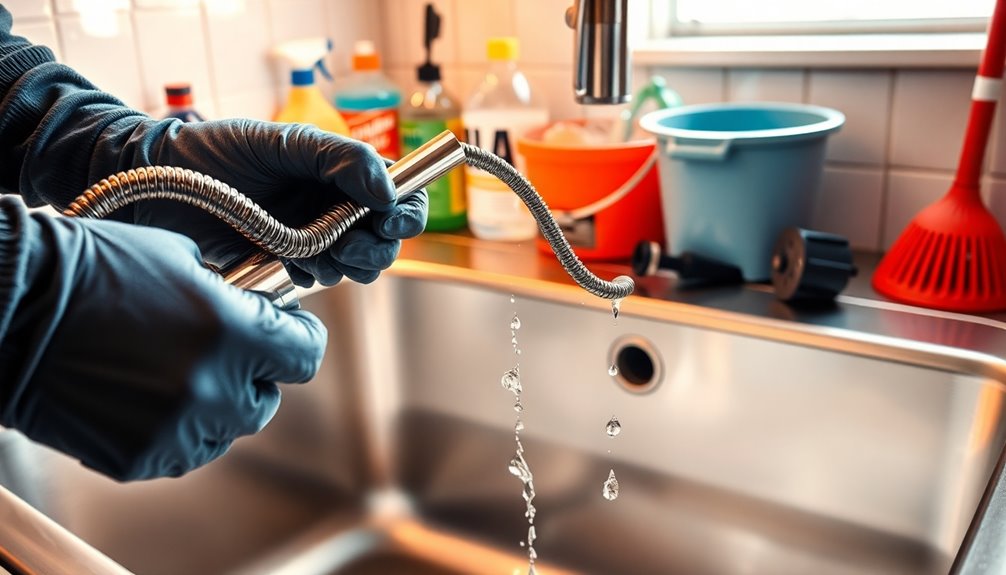
When you've tried the basics and your kitchen sink is still clogged, it's time to explore advanced techniques that can tackle stubborn blockages.
Start with a wet-dry vacuum; create a tight seal around the drain and turn it on at the highest setting to dislodge grease clogs. You can also use an auger; feed the cable until you feel resistance and crank it to break through the obstruction.
For a DIY approach, pour boiling water down the drain to melt smaller clogs, but avoid it on PVC pipes. A mixture of baking soda and vinegar creates a bubbling reaction that helps break down grease.
Finally, flush with hot water to guarantee any remaining particles are cleared. If all else fails, consider calling a professional plumber.
Regular Maintenance Tips to Prevent Future Clogs
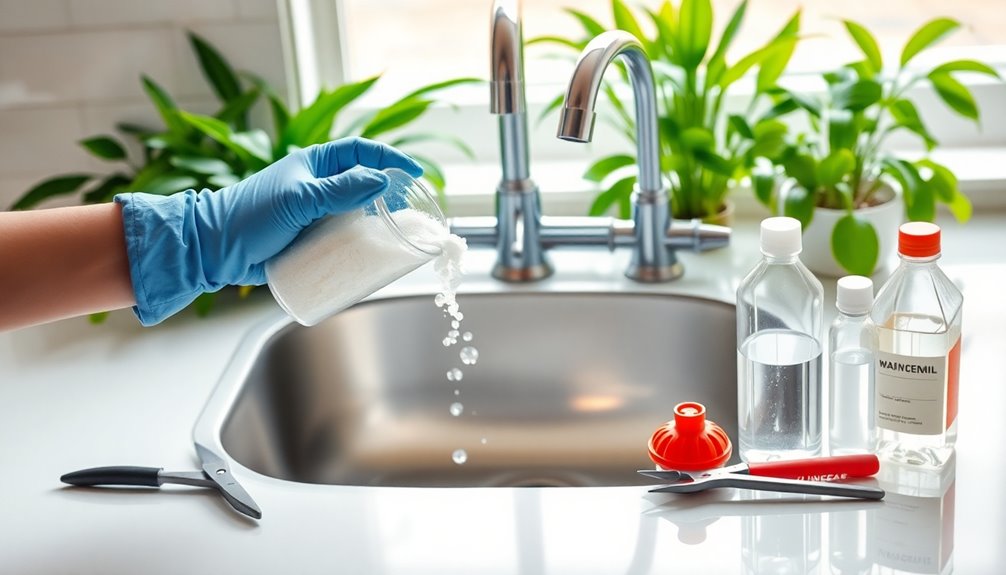
To keep your kitchen sink running smoothly and prevent future clogs, regular maintenance is essential. Here are some effective tips to help you keep the drain clear:
- Flush your drain monthly with hot water and a few drops of dish soap to break down grease.
- Use a mesh strainer to catch food particles before they can enter the drain.
- Scrape excess food and grease off plates into the trash instead of rinsing them down the sink.
- Pour a mixture of baking soda and vinegar down the drain monthly, letting it sit for 15 minutes before flushing with hot water.
- Educate everyone in your household about proper disposal methods for cooking oils and fats—never let them go down the drain!
When to Call a Professional Plumber
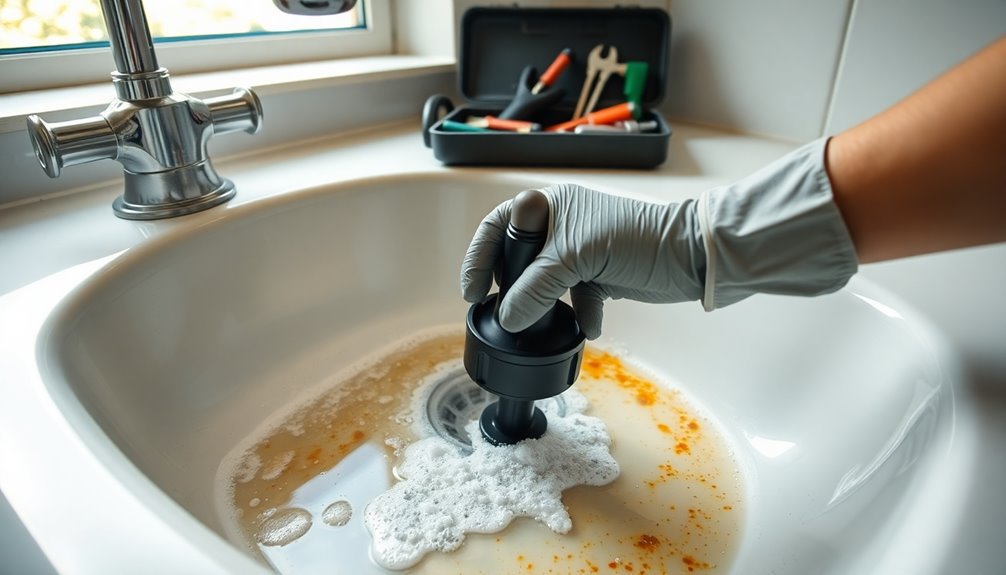
While most minor clogs can be tackled with DIY methods, knowing when to call a professional plumber can save you time and trouble.
If your attempts with baking soda and vinegar or boiling water fail after several tries, it's time to seek help. Persistent slow drainage, foul odors, or frequent backups often signal deeper issues requiring expert attention. Emotional responses can also escalate during plumbing emergencies, which might affect decision-making.
A professional plumber has specialized tools like motorized drain augers and hydro jetting equipment that can effectively address stubborn grease clogs. If the clog is deep in your plumbing, they can use cameras to inspect and resolve the issue without damaging your pipes.
Additional Remedies for Grease Removal
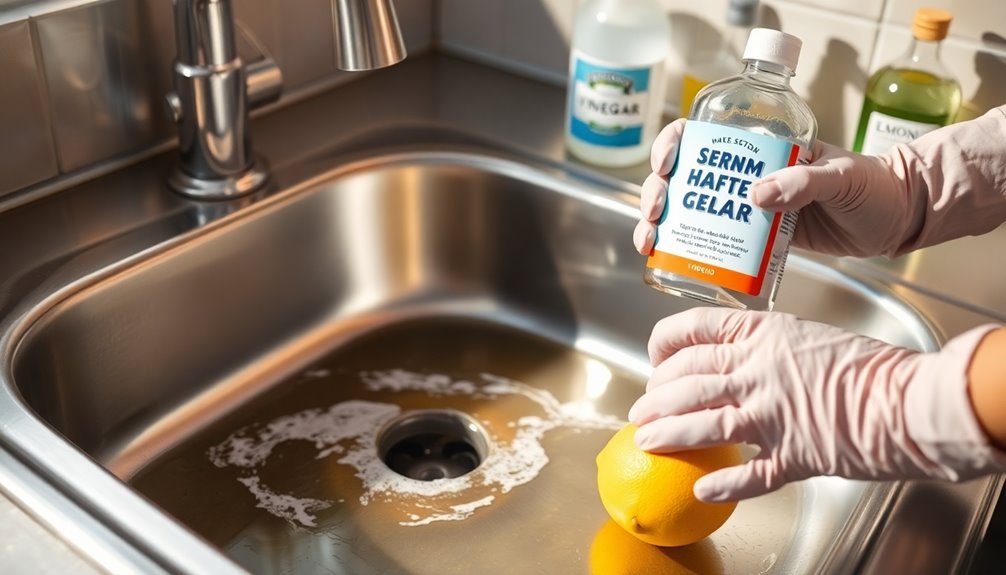
If you've ruled out the need for a professional plumber, there are several effective remedies to tackle grease buildup in your kitchen sink.
Try these methods to keep your drains clear:
- Baking Soda and Vinegar: Pour ½ cup of each down the drain, cap it for an hour, then rinse with hot water.
- Hot Water and Dish Soap: Pour dish soap followed by boiling water to break up grease.
- Ice Cubes with Vinegar: Run frozen vinegar cubes through the garbage disposal to clean and tackle minor clogs.
- Salt and Baking Soda: Mix ½ cup of each, pour it down the drain, and follow with boiling water for an abrasive clean.
- Regular Maintenance: Weekly flushing with hot water and dish soap can prevent grease buildup.
Frequently Asked Questions
What Will Dissolve Grease in a Drain?
To dissolve grease in a drain, you can use dish soap combined with hot water. This mixture breaks down fats effectively.
Another option is a baking soda and vinegar mix, which creates a bubbling reaction that helps lift grease.
Boiling water can also melt minor clogs, but be cautious with PVC pipes.
Finally, regularly flushing your drains with a hot water and vinegar mix helps prevent grease build-up, keeping your drains flowing smoothly.
How Do You Unblock Grease From a Kitchen Sink?
To unblock grease from your kitchen sink, you can start by pouring a mixture of baking soda and vinegar down the drain.
Follow that with boiling water to clear away any residue. If the clog remains stubborn, try using dish soap with hot water to break it down further.
For deeper clogs, a drain snake might be necessary. Regular maintenance, like flushing with hot water weekly, helps prevent future issues.
Will Drano Clear a Grease Clog?
Will Drano clear a grease clog? The short answer's no, it won't.
While it might seem like a quick fix, Drano's harsh chemicals can damage your pipes and won't effectively dissolve thick grease buildup.
Instead, using hot water and dish soap or natural remedies like baking soda and vinegar is safer and more effective.
If the clog persists, calling a professional plumber is your best bet for a long-term solution.
What Dissolves Fat in Drains?
To dissolve fat in drains, you can use dish soap mixed with hot water. The soap breaks down grease, making it easier to flush away.
Alternatively, combine baking soda and vinegar; their reaction helps dissolve fat while providing an abrasive action.
Boiling water can also melt fatty deposits, but be cautious with PVC pipes.
Regular maintenance with hot water and dish soap can prevent grease buildup, ensuring a smoother drainage process over time.
Conclusion
In the dance of daily cooking, grease can sometimes waltz its way into your kitchen sink, creating a stubborn clog. But with a little effort and some handy techniques, you can gracefully usher it out. By staying proactive with regular maintenance, you'll keep your drains flowing smoothly, like a gentle stream. And if that pesky clog tries to return, don't hesitate to call in a plumbing maestro to restore harmony to your kitchen sanctuary.
